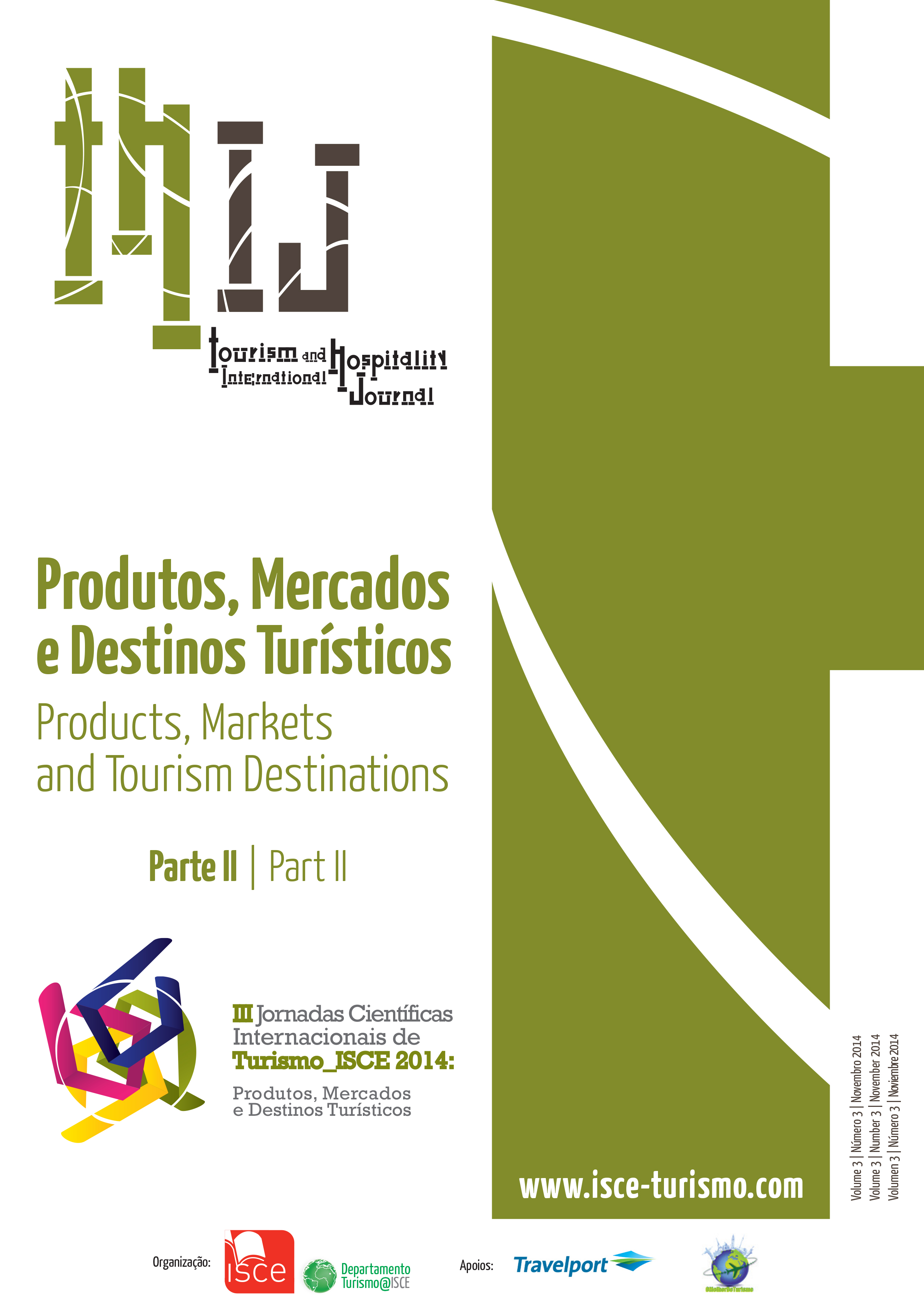Territorial marketing: Proposal for the creation of the Beja brand
DOI:
https://doi.org/10.57883/thij3(2)2014.30146Keywords:
Territorial Marketing, Brand, Consumer, BejaAbstract
In a more global and competitive, it is imperative that territories assume their role as creators of value that meets the needs and desires of its consumers/users. It is necessary to have a real perspective on how small towns can not only adapt to global change, but also increase their market competitiveness. This paper explores the characteristics and potential of territorial marketing and branding process, in order to understand what factors contribute to successful land management, and how these factors can be used on the creation of a tourism brand for the city of Beja, that reflects the attributes of the area and that creates a more attractive image to its target. For a full analysis of this theme we used two different approaches: (i) interviews with members of the regional government, the business community and the hotel business (9) and based on that information (ii) construction of a questionnaire administered to 185 tourists and residents during the year 2013.
References
Azevedo, A.; Magalhães, D. & Pereira J. (2011). City Marketing: Myplace in XXI. Porto: Editorial SA - Vida Económica.
Baker, B. (2007). Destination Branding for Small Cities: The essentials for successful place branding. Portland: Creative Leap Books.
Beerli, A. & Martin, D. (2004). Factors Influencing Destination Image. Annals of Tourism Research. (31), 657-681.
Bramwell, B. & Rawding, L. (1996). Tourism marketing images of industrial cities. Annals of Tourism Research. 23(1), 201-221.
Bryman, A. (2004). Social Research Methods. England: Oxford University Press.
Cai, L.; Gartner, W. & Munar, A. (2009). Tourism Branding: Communities in Action. Esmerald Books.
Chon, S.; Weaver, A. & Kim, Y. (1991). Marketing your community Image analysis in Norfolk. The Cornell Hotel and Restaurant Administration Quarterly. 31(4), 31-37.
De Holan, M. & Phillips, N. (1997). Sun, sand, and hard currency tourism in Cuba. Annals of Tourism Research. 24(4), 777-795.
Figueira, P. (2011). Marketing Territorial: uma nova dimensão do marketing. Estarreja: Mel Editores.
González, X. (2001). Planeamento Estratéxico e Mercadotecnia Territorial. Eixo Atlântico do Noroeste Peninsular.
Gubrium, F. & Holstein, A. (2001). From the individual interview to the interview society. In J. Gubrium, & J. Holstein (Eds.). Handbook of interview research (3-32). London: Sage.
Gulati, R.; Nohria, N. & Wohlgezogen, F. (2010). Roaring Out of Recession. Harvard Business Review. 63-69.
Hankinson, G. (2006). The Management of Destination Brands: five Guide Principles based on Recent Developments in Corporate Branding Theory. Journal of Brand Management. (14). Harlow: Prentice-Hall.
Jenkins, O. (1999). Understanding and Measuring Tourism Destination Images. International Journal of Tourism Research. (1), 1-15.
Johnson, M. (2001). In-depth interviewing. In J. Gubrium, & J. Holstein (Eds.), Handbook of interview research (103-121). London: Sage.
Ketele, M. & Roegiers, X. (1993). Metodologia da Recolha de Dados. Lisboa: Instituto Piaget.
Kotler, P. & Keller, K. (2007). A Framework for Marketing Management. England: Pearson Prentice Hall.
Kotler, P.; Haider, H. & Rein, I. (1993). Marketing Places. New York: The Free Press.
Lendrevie, J., Lindon, D., Dionísio, L., & Rodrigues, V. (1996). Mercator. Lisboa: Dom Quixote.
Marschan-Piekkari, R. & Welch, C. (2004). Handbook of Qualitative Research Methods for International Business. Edward Elgar Publishing.
Moilanen, T. & Rainisto, S. (2009). How to Brand Nations, Cities and Destinations. London: Palgrave Macmillan.
Morgan, N.; Pritchard, A. & Pride R. (2010). Destination Branding: Creating the Unique Destination Proposition. Oxford: Butterworth-Heinemann.
Porter, E. (1990). The competitive advantage of nations. New York: The Free Press.
Rainisto, K. (2003). Success Factors of Place Marketing: A study of Place Marketing practices in Northern Europe and the United States. Tese Doutoramento. Helsinki University of Technology, Institute of Strategy and International Business, Helsínquia.
Ritchie, B. & Crouch, I. (1993). Competitiveness in international tourism: A framework for understanding and analysis. Paper presented at the 43rd Congress of the International Association of Scientific Experts in Tourism, Argentina. 23-71.
Tasci, A., Gartner, C. & Gavusgil, T. (2007). Conceptualization and Operationalization of Destination Image. Journal of Hospitality & Tourism Research. (31), 198-222.
Therkelsen, A. & Gram, M. (2008). The Meaning of Holiday Consumption: Construction of self among Mature Couples. Sage Publications. 8(2), 269-292.
Downloads
Published
How to Cite
Issue
Section
License
Copyright (c) 2023 This work is licensed under a Creative Commons - Attribution 4.0 International (CC BY 4.0)

This work is licensed under a Creative Commons Attribution 4.0 International License.
This work is published under the Creative Commons Attribution 4.0 International License.






